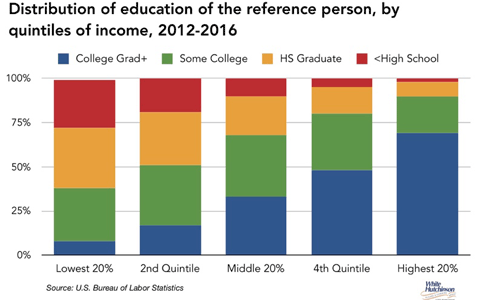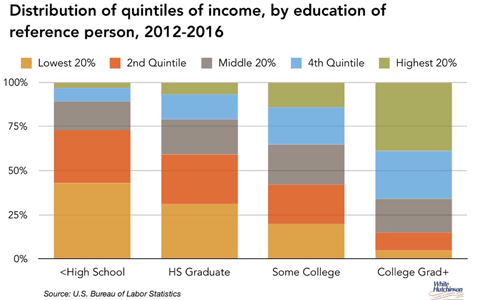
Vol. XVIII, No. 8, September 2018
- Editor's corner
- A snapshot at out-of-home 'entertainments' True Reality
- College educated women delaying motherhood
- It's time to kill the FEC Industry (name)
- American's pizza obsession
- Holey Moley, it's a mini golf cocktail bar
- What's happening with at-home and mobile screen video game play?
- Is your center Snapchat geofenced?
- Time saved, or time well spent?
- Decline in births now equals the drop during the Great Depression
- What matters, income or education?
What matters, income or education?
When performing market feasibility analysis or analyzing the characteristics of current customers, there are multiple sociodemographic measures that can be used. These include age, gender, type of living accommodations, type of household, income, education and lifestyles.
Almost all studies for out-of-home leisure venues use incomes to identify target markets based on the direct correlation between income and participation and spending at out-of-home leisure venues, especially entertainment. However, often education can be a better predictor of behavior, as there is a far closer relationship between values and education than there is with income. A person's values are a significant factor in determining their behaviors. When our company conducts feasibility studies, we give education a lot of weight.
There is a relationship, a correlation between education and income. Generally, higher educated people have higher incomes. If you've ever wondered what the relationship is, check out these two graphs we created.


69% of the reference adults (the adult surveyed) in households with the highest 20% of incomes were college graduates whereas only 39% of college graduates belong to households with the top 20% of income households. When it comes to having only a high school degree, only 8% are in the top 20% of householders by income whereas only 7% of high school only graduates belong to the top 20% of income households.
Yes, it can get rather confusing. That is why in our company's market feasibility studies we also use a classification system that breaks households into 65 different distinct lifestyle segments based upon similarity of demographics, socioeconomics, lifestyles, values and customer behaviors.
We find that such a system is a much more reliable and useful tool for guest segmentation analysis than demographics. Available demographic data generally only aggregates households and families and does not provide as detailed an analysis to identify a very specific target market. Socioeconomic-lifestyle segmentation addresses peoples behaviors and values, a more useful predictor of consumer behavior than demographics.
So analyzing and segmenting markets by incomes doesn't give you a complete and accurate picture. Many other characteristics also need to be examined, including education and socioeconomic-lifestyles.
Vol. XVIII, No. 8, September 2018
- Editor's corner
- A snapshot at out-of-home 'entertainments' True Reality
- College educated women delaying motherhood
- It's time to kill the FEC Industry (name)
- American's pizza obsession
- Holey Moley, it's a mini golf cocktail bar
- What's happening with at-home and mobile screen video game play?
- Is your center Snapchat geofenced?
- Time saved, or time well spent?
- Decline in births now equals the drop during the Great Depression
- What matters, income or education?


